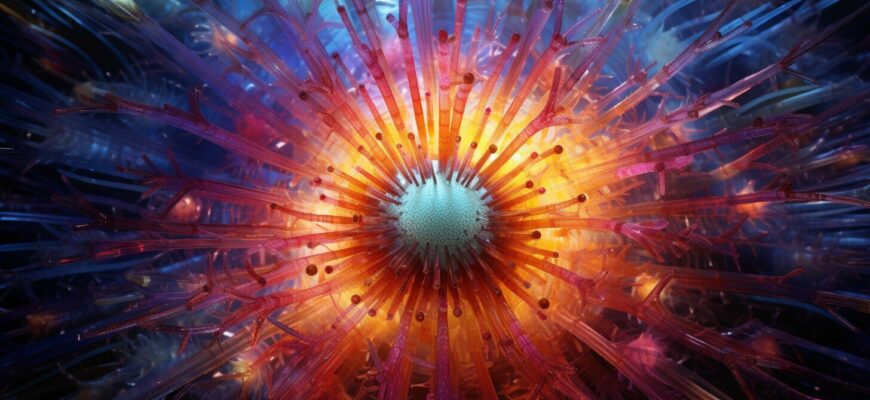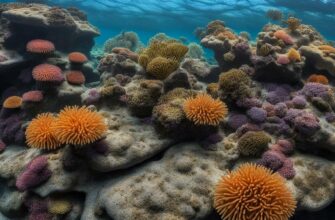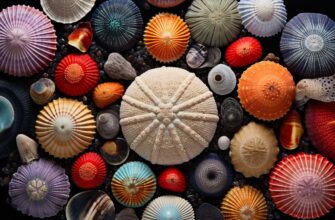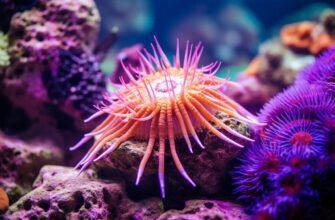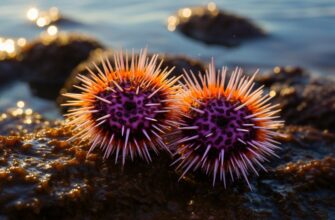Sea urchins are fascinating creatures that belong to the echinoderm family, which also includes starfish and sea cucumbers. They have been around for approximately 450 million years and are found in oceans all over the world. One of the most debated topics regarding sea urchins is whether or not they feel pain.
Before we dive into this topic, it’s essential to understand the sensory perception of sea urchins. Unlike humans, who rely on sight, smell, taste, touch, and hearing to make sense of their environment, sea urchins use various sensory organs located on their body to perceive their surroundings.
- Anatomy and Nervous System of Sea Urchins
- Anatomy of a Sea Urchin
- Sensory Organs of Sea Urchins
- Behavioral Responses of Sea Urchins
- Feeding Behavior
- Response to Injury
- Scientific Studies on Sea Urchin Sensitivity
- Studies on Sea Urchin Behavior
- Studies on Nociceptors in Sea Urchins
- Studies on Gene Expression in Sea Urchins
- Limitations of Sea Urchin Studies
- Evolutionary Perspectives on Pain in Sea Urchins
- Sea Urchin Sensory Systems
- Ethical Considerations and Sea Urchin Research
- Frequently Asked Questions (FAQs) about Sea Urchin Pain Perception
- Can sea urchins feel pain?
- Do sea urchins have a response to potentially harmful stimuli?
- Is it ethical to use sea urchins in scientific research?
- Why do researchers study sea urchins?
- Do sea urchin populations face any threats?
- Can sea urchins regenerate their spines?
- Are there any potential applications for sea urchin research?
Anatomy and Nervous System of Sea Urchins
Sea urchins belong to the phylum Echinodermata, which also includes starfish and sea cucumbers. They have a unique anatomy compared to other animals, featuring a round, spiny body with a mouth on the underside and a complex water vascular system that powers their tube feet.
Despite their lack of a centralized brain, sea urchins possess a decentralized nervous system that allows them to process sensory information and react to their environment. Their nervous system is composed of a nerve ring that surrounds the mouth and nerve cords that extend outward to the tips of their spines and tube feet.
Recent studies have also found specialized cells in the spines of sea urchins that can detect changes in their orientation and help them navigate their surroundings. These cells, called mechanoreceptors, respond to mechanical pressure and movement.
Anatomy of a Sea Urchin
| Body Part | Description |
|---|---|
| Test | The round, hard shell of the sea urchin covered in spines. |
| Mouth | Located on the underside of the sea urchin, surrounded by five teeth that scrape algae and other food from surfaces. |
| Feet | Hollow tubes that extend from the test and can be used for movement, gripping surfaces, and feeding. |
| Ambulacral grooves | Channels on the underside of the sea urchin that contain tube feet. |
The water vascular system of sea urchins is also closely intertwined with their nervous system, allowing them to control the movement of their tube feet and spines. When water is pumped into their tube feet, they can extend and retract them to walk along surfaces or grasp objects.
Overall, the unique anatomy and nervous system of sea urchins enable them to perceive and respond to their environment in a variety of ways, despite their lack of a centralized brain.
Sensory Organs of Sea Urchins
Sea urchins have a range of sensory organs that allow them to detect and respond to changes in their environment. These organs are located on the animal’s body surface, and are largely responsible for the sea urchin’s ability to interact with its surroundings.
One of the most important sensory organs in sea urchins is the tube feet, which are responsible for locomotion and detecting changes in the animal’s environment. These feet are equipped with sensory cells that are sensitive to touch, allowing the sea urchin to sense the texture and hardness of surfaces it comes into contact with.
Another important sensory organ is the spines, which also have sensory cells that allow the sea urchin to detect changes in its environment. These spines are used for protection, but also help the sea urchin to feel its way around its surroundings.
In addition to the tube feet and spines, sea urchins also have sensory cells located on their oral and aboral surfaces, which allow them to detect changes in light, temperature, and water flow. These cells are important for navigation and help the sea urchin to locate food and avoid predators.
Overall, the various sensory organs of sea urchins allow them to interact with their environment in a sophisticated way, detecting changes and responding appropriately. While the exact nature of their sensory perception remains a topic of study, it is clear that sea urchins are equipped with a range of sensory organs that play a critical role in their survival.
Behavioral Responses of Sea Urchins
Sea urchins exhibit a variety of behavioral responses to different stimuli, such as light, touch, and chemicals. These responses are controlled by their nervous system, which is distributed throughout their body and consists of a complex network of nerve cells.
When exposed to a threatening stimulus, such as a predator, sea urchins may exhibit defensive behaviors, such as hiding or aggregating together. They may also move to avoid the threat, such as by crawling away or using their spines to push off a surface.
Feeding Behavior
Sea urchins are herbivores and use their unique mouth structure, called Aristotle’s lantern, to scrape algae and other plant material from rocks and other surfaces. They have been observed to exhibit positive feeding responses to certain stimuli, such as the presence of food or pheromones released by other sea urchins.
Response to Injury
Sea urchins can also exhibit a response to injury, such as regenerating lost spines or covering damaged areas with new skeletal material. However, it is unclear whether this response indicates pain perception or is simply a reflexive reaction.
“While sea urchins do exhibit behavioral responses to different stimuli, it is still unclear whether these responses indicate the presence of pain perception.”
Overall, the behavioral responses of sea urchins are complex and varied, and more research is needed to determine whether they experience pain or simply respond to stimuli reflexively.
Scientific Studies on Sea Urchin Sensitivity
Despite their lack of a central nervous system, many have questioned whether sea urchins are capable of feeling pain. This has led to various scientific studies investigating the sensitivity of these marine creatures.
Studies on Sea Urchin Behavior
One study published in the journal Behavioural Processes observed the behavior of sea urchins when exposed to different stimuli. The researchers found that when exposed to noxious stimuli, sea urchins exhibited avoidance behavior and increased movement, suggesting a possible experience of pain.
Studies on Nociceptors in Sea Urchins
Another study published in the journal The Biological Bulletin investigated the presence of nociceptors, sensory receptors that respond to potentially damaging stimuli, in sea urchins. The study found that certain sensory cells in the spines of sea urchins responded to a range of stimuli, including heat, cold, and high salt concentrations, suggesting that these creatures have a complex sensory system.
Studies on Gene Expression in Sea Urchins
Researchers have also examined the gene expression patterns of sea urchins in response to different stimuli. A study published in the journal Comparative Biochemistry and Physiology Part A: Molecular & Integrative Physiology found that genes associated with stress response and inflammation were upregulated in sea urchins exposed to potentially noxious stimuli, further supporting the notion that these creatures are capable of experiencing pain.
Limitations of Sea Urchin Studies
Despite these findings, some researchers caution that studying the pain perception of sea urchins is difficult. Due to their lack of a central nervous system, it is challenging to determine whether the behavioral responses exhibited by sea urchins are indicative of actual pain perception or simply reflexes. Furthermore, sea urchins are difficult to study in their natural environment, making it challenging to replicate real-world scenarios in a laboratory setting.
Overall, while scientific research has provided some evidence for the potential pain perception of sea urchins, the topic remains a subject of debate among researchers.
Evolutionary Perspectives on Pain in Sea Urchins
Understanding sea urchins’ ability to feel pain requires consideration of their evolutionary history and ecological roles. Sea urchins belong to the phylum Echinodermata, which also includes starfish, sea cucumbers, and brittle stars. This phylum diverged from the ancestor of other animals over 500 million years ago.
Sea urchins play crucial roles in marine ecosystems, acting as herbivores that graze on algae and serving as food for predators such as otters, crabs, and birds. Their hard shells also provide habitat for other organisms. These ecological roles suggest that sea urchins have evolved complex sensory systems to detect changes in their environment.
Research suggests that sea urchins’ sensory systems are highly advanced, capable of detecting light, chemicals, and mechanical stimuli. However, the evolutionary drivers behind pain perception in sea urchins remain unclear. Some researchers argue that pain perception may have evolved as a mechanism to avoid harmful stimuli. Others suggest that it may have evolved as a byproduct of other sensory systems.
Sea Urchin Sensory Systems
Sea urchins possess a range of sensory organs, including tube feet, pedicellariae, and spines. These organs are believed to play a role in detecting changes in light, temperature, mechanical pressure, and chemicals such as pheromones.
One of the most studied sensory organs in sea urchins is the tube feet. These structures are used for locomotion, but they also contain sensory cells that can detect a range of stimuli. These cells are thought to be connected to nerve cells that carry signals to the sea urchin’s nervous system.
Pedicellariae are small pincer-like structures that are found on the surface of sea urchins. They are believed to function in a defensive capacity, protecting sea urchins from predators. Recent research has suggested that pedicellariae may also play a role in sensory perception, detecting vibrations and chemical cues in the environment.
Ethical Considerations and Sea Urchin Research
The issue of animal welfare is a crucial aspect of scientific research, and sea urchins are no exception. As with any animal used in research, it is important to consider the potential ethical implications of studying sea urchins.
The use of sea urchins in research has been controversial due to concerns about their welfare. Some have argued that sea urchins may experience pain and suffering, and may not be able to fulfill their behavioral and physical needs when kept in captivity.
However, others argue that sea urchins are simple organisms and are not capable of experiencing pain in the same way that more complex animals, such as mammals, do. Additionally, strict regulations and guidelines are in place to ensure that sea urchins are treated humanely during research studies.
Despite these regulations, it is important for researchers to consider the ethical implications of their work and to minimize any potential harm to the sea urchins.
| Ethical Considerations | Implications |
|---|---|
| Use of Anesthetics | To minimize any potential pain or discomfort during experimental procedures, the use of anesthetics should be considered. |
| Sample Sizes | Researchers should carefully consider the number of sea urchins used in experiments and try to minimize the number of animals used. |
| Experimental Procedures | Researchers should carefully design experiments to ensure that they are necessary and that the sea urchins’ welfare is not compromised. |
Ultimately, the question of whether sea urchins can experience pain remains a complex and debated issue, and it is important for researchers to consider the ethical implications of their work.
Frequently Asked Questions (FAQs) about Sea Urchin Pain Perception
After exploring the sensory perception and behavior of sea urchins, you may have some questions about their ability to experience pain. Here are some frequently asked questions:
Can sea urchins feel pain?
The scientific consensus is that sea urchins do not experience pain in the way that humans do. Their nervous system is not complex enough to support the processing of pain signals in the same way our nervous system does.
Do sea urchins have a response to potentially harmful stimuli?
Yes, sea urchins have a range of protective behaviors that can be triggered by potentially harmful stimuli. These include moving away from danger, closing their spines to form a protective barrier, and releasing toxins into the water.
Is it ethical to use sea urchins in scientific research?
As with all animal research, there are ethical considerations to take into account. However, compared to many other animals used in scientific research, sea urchins are relatively simple organisms with limited capacity for complex experiences like pain. Additionally, researchers are required to follow strict ethical guidelines and obtain approval from institutional animal care and use committees before conducting any experiments.
Why do researchers study sea urchins?
Sea urchins are fascinating organisms with a range of unique biological features. They are used in a variety of scientific studies, from basic research on evolutionary biology and developmental processes to applied research on ocean acidification and the effects of pollutants on marine ecosystems.
Do sea urchin populations face any threats?
Like many marine organisms, sea urchin populations face threats from climate change, pollution, and overfishing. Some species of sea urchin are also targeted for their roe, which is considered a delicacy in some cultures.
Can sea urchins regenerate their spines?
Yes, sea urchins have an incredible capacity for regeneration. They can regenerate not only their spines, but also their entire body if a portion is lost. This makes them an important model organism for studying the mechanisms of tissue regeneration.
Are there any potential applications for sea urchin research?
Yes, sea urchin research has a range of potential applications, from developing new medical treatments to improving our understanding of marine ecosystems. For example, researchers are exploring the use of sea urchin-derived compounds for treating cancer, and studying the effects of ocean acidification on sea urchin larvae to better understand the impacts of climate change on marine life.
We hope these FAQs have helped to answer some of your questions about sea urchin pain perception. Despite their reputation as spiny creatures, sea urchins are fascinating organisms with much to teach us about the natural world.

